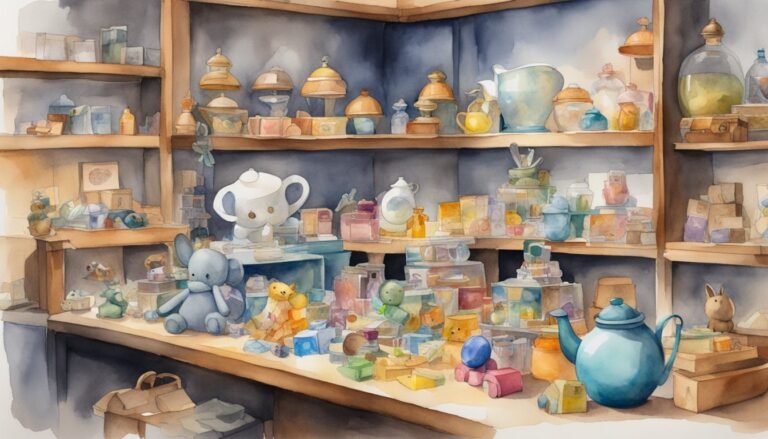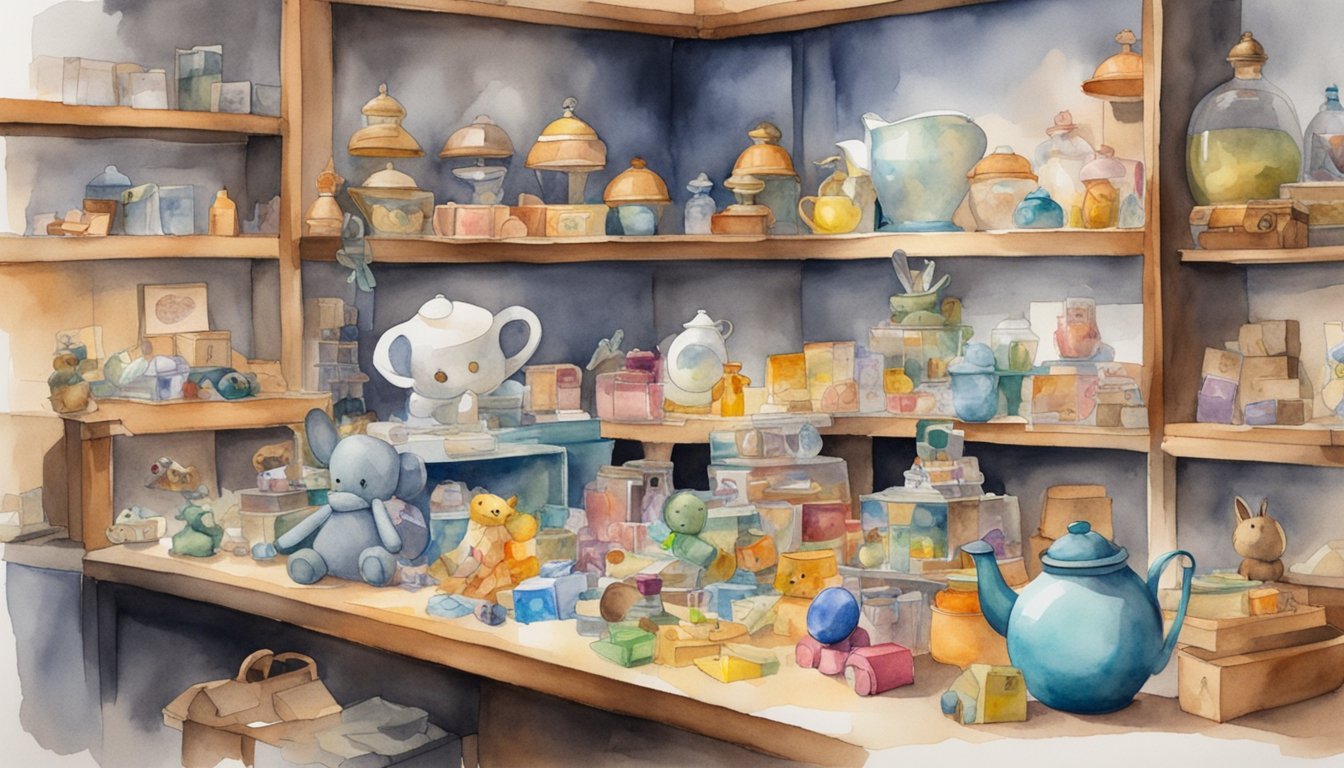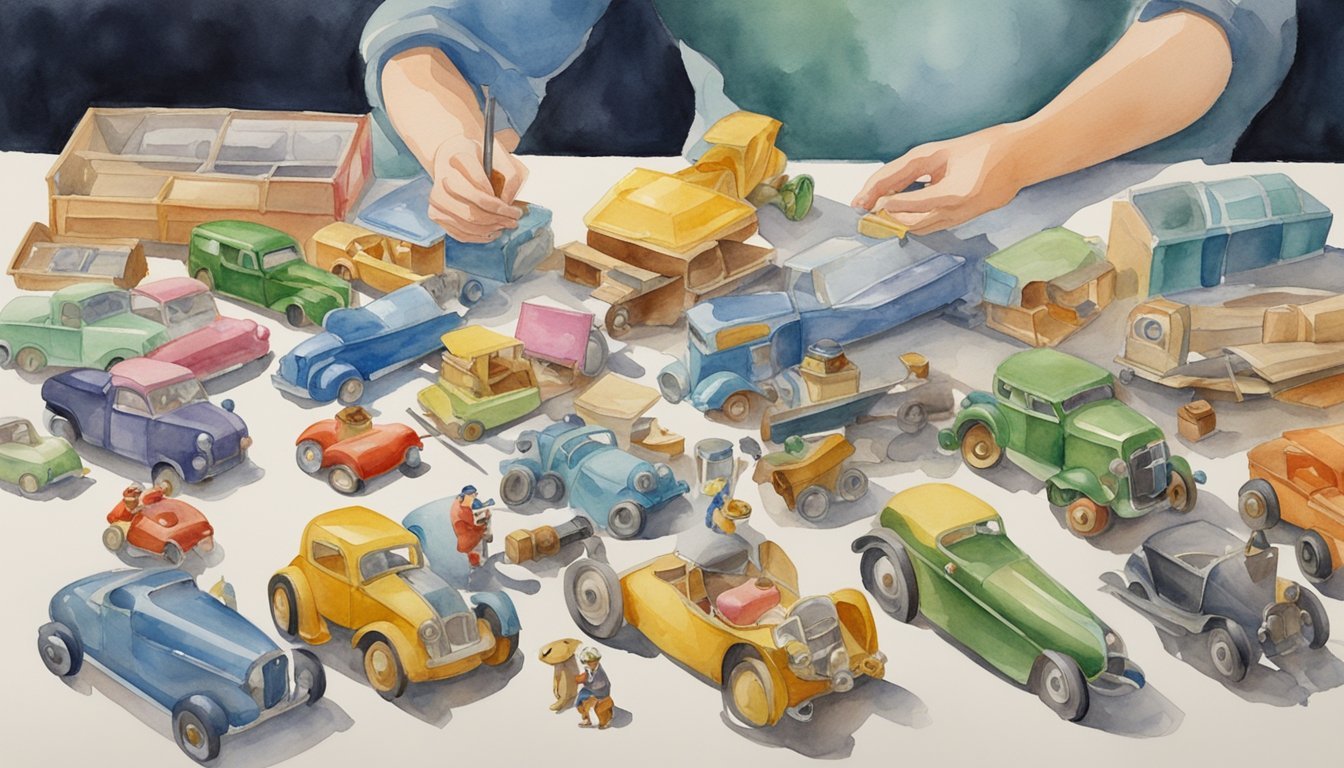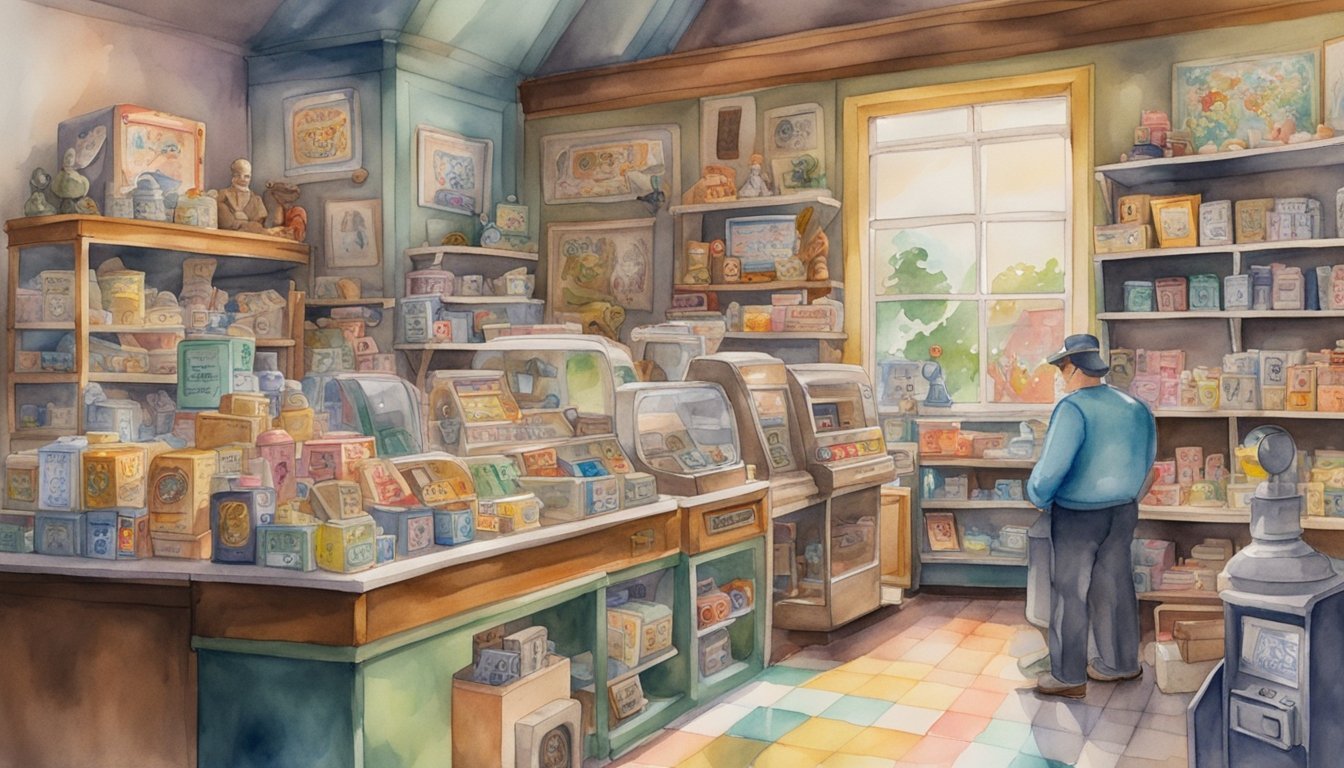Vintage Toy Reselling: Your Fun and Profitable Side Hustle

Have you ever looked at your old toys and wondered if they could be worth something? Reselling vintage toys can be a rewarding side hustle that turns childhood memories into cash. Vintage toys, especially those in good condition or from well-known brands like Lego, Fisher-Price, and Hot Wheels, can fetch impressive prices.

Whether you have a collection collecting dust or enjoy hunting for rare finds at garage sales, there’s a thriving market eager to buy what you have.
Platforms like eBay, Etsy, and specialized sites such as Neatstuff Collectibles make it easy to connect with collectors worldwide.
By understanding factors like condition, rarity, and demand, you can maximize your profits.
It’s not just about listing items—you need to know how to price, present, and promote them effectively.
Ready to dive into the exciting world of vintage toy reselling? Let’s get started.
Key Takeaways
- Vintage toys can be a lucrative side hustle if in good condition.
- Use platforms like eBay, Etsy, and specialized sites to reach collectors.
- Understand the value and demand to price and market your toys effectively.
Understanding Vintage Toy Reselling
Reselling vintage toys can be a profitable and enjoyable side hustle.
Key factors include the appeal of vintage toys, identifying collectibles, and determining their rarity and value.
The Appeal of Vintage Toys
Vintage toys attract collectors due to their nostalgia and rarity.
Older toys often remind people of their childhood, creating an emotional bond that drives demand.
Additionally, some toys from the past are hard to find, making them even more desirable.
Toys from well-known brands, like action figures or dolls, often fetch higher prices.
The unique designs and materials of older toys also add to their charm, setting them apart from modern alternatives.
The important thing is to understand why collectors seek these items.
It’s about more than just the toy itself; it’s the memories and stories behind them that make them special.
Identifying Collectibles
Identifying which toys are collectible is crucial for your reselling success.
Look for toys that were popular during their time and have a loyal fan base.
Action figures, model cars, and classic board games are examples of such items.
Check for brand marks, production years, and unique features to confirm authenticity.
Toys in their original packaging are generally more valuable.
Limited edition or promotional items also hold higher value.
You can use online resources to help identify and price your toys.
Search for “[Brand or Line Name] wiki](https://retrogeektoys.com/articles/how-to-sell-vintage-toys-the-ultimate-guide-pricing-shops-and-tips)” to find detailed information about specific toys.
Determining Rarity and Value
Determining the rarity and value of vintage toys involves research and appraisal.
Toys that were produced in limited quantities or discontinued early are often rare and sought after.
Rarity increases value, especially if the toy is in good condition.
Condition matters a lot.
Mint condition toys, especially those unopened, can command higher prices.
Look for toys without damage, fading, or missing parts.
Using price guides and online marketplaces helps gauge current market value.
You can also get professional appraisals for highly valuable toys.
Knowing a toy’s worth ensures you set a competitive price and maximize your profit when reselling vintage toys.
Getting Started with Reselling
Starting your vintage toy reselling side hustle can be exciting and profitable.
You need to understand the basics of reselling and organize your business efficiently to succeed.
Reselling Basics
Begin by researching the market for vintage toys.
Check out thrifting for profit to see what types of toys are popular and how they are priced.
Tools like eBay and Etsy can help gauge demand and pricing.
Next, source your toys.
Visit thrift stores, garage sales, and online auctions to find valuable items.
Building relationships with store managers might get you early access to new inventory.
Look for toys in good condition and make a list of repair tips to fix minor damages.
When buying, consider the rarity and nostalgia factor.
Vintage toys from popular brands often fetch higher prices.
Use keywords like “1970s action figures” or “vintage Barbie dolls” when searching online listings.
Know the market trends for pricing.
A rare item might fetch a premium price, while more common pieces should be moderately priced to sell quickly.
Setting Up Your Business
To set up your reselling business, create a plan outlining your goals, budget, and strategies.
Design a logo and brand name that reflects the nostalgia of vintage toys.
Register your business if needed.
Set up an online store or use platforms like ProfitDuel.
High-quality photos and detailed descriptions are crucial.
Mention any accessories, year of manufacture, and any trademarks.
The more information, the better.
Start by selling locally to build experience.
Participate in pop-up markets or organize garage sales.
You can move online once you get more comfortable and confident.
Track your expenses and earnings to understand your profit margins.
Use spreadsheets or accounting software to manage your finances.
This will help you identify your most profitable items and adjust your strategy as needed.
Sourcing and Acquiring Vintage Toys
To get started in vintage toy reselling, you need to know where to find valuable items and how to negotiate the best deals.
Exploring various sources and honing your negotiation skills can help you acquire toys at great prices.
Where to Find Vintage Toys?
You have several options when searching for vintage toys. Thrift stores are a popular choice, often carrying hidden gems at low prices.
Regular visits can increase your chances of finding valuable items.
Yard sales are another great source.
Many people sell old toys at extremely low prices, simply to clear clutter.
Checking local listings or driving around neighborhoods on weekends can yield some great finds.
Online marketplaces like eBay and Etsy are also valuable for sourcing vintage toys.
You can browse listings from the comfort of your home, and there are often many options available.
Using specific search terms can help you find the exact items you’re looking for.
Another option to consider is auction houses.
While these can be pricier, they often have rare and high-value toys that can significantly boost your profits.
Keep an eye on auction schedules and attend them when possible.
Negotiating the Purchase
Negotiating is key when acquiring vintage toys.
At yard sales, sellers often expect haggling.
Start with a lower offer than the asking price but be reasonable to avoid offending the seller.
In thrift stores, prices are usually fixed, but you might get a discount if you buy in bulk.
Always ask if there’s room for negotiation, especially if you’re a frequent shopper.
For online marketplaces, bidding can be competitive.
Set your maximum bid beforehand to avoid overspending.
On platforms like eBay, using the “Make Offer” option can also lead to better deals.
At auction houses, research the estimated value of toys before bidding.
Stick to your budget and don’t get caught up in bidding wars.
Knowing when to walk away is crucial to maintaining your profits.
By utilizing these strategies, you can effectively source and acquire vintage toys for your reselling side hustle.
Evaluating Condition and Completeness

When reselling vintage toys as a side hustle, understanding both the toy’s condition and its completeness are key to maximizing profits.
Assessing Toy Conditions
To get the best price, you need to assess your toy’s condition accurately.
This means looking for any wear, damage, or repairs.
A toy in mint condition will have no signs of damage and is usually the most valuable.
On the other hand, a toy with scratches, missing parts, or signs of repair will be worth less.
You should also note any discoloration or fading in the toy’s paint or plastic.
Check for rust on metal parts and ensure any moving parts function properly.
Take clear photos and give honest descriptions if you intend to sell online.
Understanding Completeness
Completeness refers to whether the toy has all its original parts and accessories.
A vintage Barbie doll with her authentic attire, for instance, can fetch a high price at auctions.
Missing parts can drastically reduce a toy’s value.
For action figures, make sure they come with all weapons, stands, and other accessories.
If your toy originally came in a box, having the original packaging can also add to its value.
Complete sets, like board games with all pieces intact, are particularly desirable to collectors.
Using detailed descriptions and photos can help show the toy’s completeness to potential buyers.
Make sure to list every included item to give a clear picture of what’s on offer.
This section is finalized based on the given instructions and remaining information.
Pricing and Valuation Strategies
To make money reselling vintage toys, you need to figure out how much they’re worth and set prices that attract buyers.
The aim is to get top dollar for your items while remaining competitive.
Researching Market Prices
First, you need to know the market value of your vintage toys.
Check online marketplaces like eBay, Etsy, and specific toy auction sites.
Search for similar toys to see what they’re selling for.
Visit collector forums and price guides to get additional insights.
Sometimes, auction houses publish price lists for past sales, which can be helpful.
Take notes on what impacts the price, like condition, rarity, and whether the toy has its original packaging.
Check for any trends, like certain toys becoming more popular recently.
This research gives you a good idea of what to expect.
Setting Competitive Prices
Once you know the market value, it’s time to set your prices.
If you’re selling on online marketplaces, you might want to price slightly lower than the competition to attract buyers quickly.
You can always adjust the price later.
For rare or mint-condition toys, consider listing them at a higher price.
You could also use a price guide as a benchmark.
If you’re selling through an auction house, start with a base price that covers what you need to make a profit.
Remember to factor in any fees or commissions from the sale.
By setting thoughtful and competitive prices, you’ll be better positioned to make a good profit on your vintage toy side hustle.
Creating Compelling Listings

To attract buyers and increase the chances of selling your vintage toys, you need to create listings that stand out.
Focus on writing engaging descriptions and using relevant keywords to draw in potential buyers.
Writing Descriptions That Sell
A good description should tell a story.
Start by detailing the toy’s unique features, including its brand, year of manufacture, and any special characteristics.
For example, if you’re selling a 1980s Transformers action figure, mention its rarity, condition, and any original packaging.
Be honest about the toy’s condition.
If it has some wear and tear, highlight it.
Buyers appreciate transparency and are more likely to trust you.
Use bullet points to list key features:
- Brand: Hasbro
- Year: 1985
- Condition: Good, minor scratches on the left arm
Include a brief history if possible.
A toy’s backstory can make it more appealing, sparking nostalgia and interest.
Using Keywords Effectively
Keywords help your listing show up in search results.
Start by researching common search terms related to your toy.
For instance, if you’re selling a vintage Barbie doll, use keywords like “vintage Barbie”, “1980s Barbie doll”, and “collector Barbie”.
Place these keywords in the title and description but avoid keyword stuffing.
A natural flow ensures readability and keeps readers engaged.
Incorporate keywords in your image alt text too.
Descriptive tags improve visibility in image searches.
For example:
- Title: Vintage 1980s Barbie Doll – Excellent Condition
- Description: Collectors’ item, 1980s Barbie doll in excellent condition, a must-have for any vintage toy enthusiast.
This approach attracts buyers looking for specific items and features.
Choosing Where to Sell
Selling vintage toys as a side hustle can be done through various platforms.
You can choose online marketplaces for broader reach, local selling options for direct interactions, or specialty toy auctions for targeting collectors.
Online Marketplaces
Online marketplaces like eBay, Etsy, and Amazon offer a wide audience. eBay is great for auction-style listings, helping you get the best price from motivated buyers. Etsy is ideal for more niche items or handmade toys, appealing to a specific audience. Amazon can work well for more popular or rare items due to its vast user base.
You can also use Facebook Marketplace for local sales.
It’s quick and easy, allowing you to connect directly with buyers in your area.
This can reduce shipping costs and help build a local customer base.
Local Selling Options
Selling locally provides direct interaction with buyers and often faster sales.
Garage sales and flea markets are traditional methods but can still be effective.
Consignment shops offer another route, where you leave your items, and the shop sells them on your behalf.
You’ll share the profit but won’t have to handle the sales process.
Local toy or collectible stores may also buy vintage toys.
These stores have targeted clientele, so your vintage items may sell faster.
Always check with store policies beforehand, as some may buy outright while others may offer store credit.
Specialty Toy Auctions
Specialty toy auctions focus specifically on collectibles and rare items.
These auctions attract serious collectors willing to pay top dollar for unique toys.
You can find these auctions through online platforms or local auction houses specializing in vintage toys.
Participating in these auctions might require a bit more effort and understanding of the market, but the payoff can be significant.
Research the auction company’s reputation and past auction results to ensure it’s worth your time.
Marketing and Promoting Your Listings
When trying to sell vintage toys, it’s important to reach potential buyers effectively.
Using social networks and making direct connections with collectors can increase your chances of a successful sale.
Leveraging Social Networks
Social media is a powerful tool for reaching a broad audience.
Platforms like Facebook, Instagram, and TikTok allow you to showcase your vintage toys with engaging photos and videos.
Create dedicated pages or profiles for your side hustle.
Post regularly to keep your audience interested.
Join relevant groups and communities to share your listings and engage with potential buyers.
Use hashtags to increase visibility.
For example, you can use #vintagetoys, #toycollector, and #retrotoys.
This helps attract users interested in these topics.
Collaborating with influencers in the vintage toy niche can also help you reach a larger audience.
Offer them a toy in exchange for a shoutout or a review.
Connecting with Collectors
Building relationships with collectors is key.
Collectors are often willing to pay more for items they want, making this a lucrative strategy.
Attend toy fairs, conventions, and local meetups where collectors gather.
This helps you make face-to-face connections and build trust.
Create an email list to keep collectors updated on new listings.
Send regular updates about your latest finds and upcoming sales.
Also, participate in online forums and communities dedicated to vintage toys.
Engage in discussions, share your expertise, and promote your listings subtly.
Collectors appreciate detailed information.
Always provide clear descriptions and high-quality photos.
Highlight any unique features or the historical significance of a toy to make it more appealing to collectors.
Handling Transactions and Customer Service

When reselling vintage toys as a side hustle, managing transactions and providing excellent customer service are crucial.
Ensure secure payments, handle shipping costs effectively, and keep customers happy to build a steady stream of loyal buyers.
Navigating Online Payment Systems
Using online payment systems like PayPal, Venmo, or Stripe can make transactions smoother.
These platforms are easy to use and secure, giving both you and your customers peace of mind.
Be mindful of any fees these services might charge, as they can eat into your profits.
Always be clear about shipping costs upfront to avoid any misunderstandings.
In some cases, offering multiple payment options can attract more buyers.
For example, accept credit cards, despite the processing fees, to cater to a wider audience.
Also, consider using e-commerce platforms like eBay or Etsy, which handle payments and have integrated seller protections.
Providing Top-Notch Customer Experiences
Customer service can make or break your vintage toy reselling business.
Start by responding promptly to inquiries; quick replies can convert potential customers into buyers.
Always provide detailed descriptions and clear photos of the toys you’re selling to set accurate expectations.
Offering good packaging is essential to prevent damage during shipping.
Use sturdy boxes and bubble wrap, especially for delicate items.
Tracking numbers offer transparency and help build trust.
Be prepared to handle returns and complaints gracefully.
A flexible return policy can enhance customer satisfaction, even if it means occasionally absorbing return shipping costs.
Your goal is to leave a positive impression, encouraging repeat business and positive reviews.
Packing and Shipping Best Practices
When reselling vintage toys as a side hustle, proper packing and choosing the right shipping carrier are crucial.
These steps ensure your items arrive safely and maintain their value, which can boost your profits and customer satisfaction.
Securing Your Vintage Toys for Transit
To pack your vintage toys safely, you need the right materials.
Start with bubble wrap for cushioning the toys.
Wrap each toy individually to prevent scratches and dents.
Use sturdy boxes that are slightly bigger than the wrapped toys.
Fill any empty spaces with packing peanuts or crumpled paper to avoid movement during shipping.
For delicate items, consider double-boxing.
Place the wrapped toy in a smaller box, then put that box inside a larger one with extra padding between the two.
Seal the box securely with heavy-duty packaging tape.
Label the package as “Fragile” to alert handlers.
Proper packing protects the toys from transit damage, ensuring they arrive in the condition your buyers expect.
Choosing the Right Shipping Carrier
Selecting the right shipping carrier impacts both cost management and delivery reliability.
When deciding on a carrier, compare rates and services.
USPS is often cost-effective for smaller packages.
They offer flat-rate boxes, which can help manage shipping costs if your toys fit within the dimensions.
UPS and FedEx are good options for larger or heavier items.
They provide tracking services, which can be valuable for high-value shipments.
Consider insurance for expensive items.
This adds a layer of protection in case of loss or damage.
Check carrier reviews to ensure they handle packages gently, which is especially important for valuable vintage toys.
Managing these aspects carefully can help you keep shipping costs reasonable while ensuring your items arrive in excellent condition.
Expanding Your Toy Reselling Business

To grow your toy reselling business, focus on diversifying your inventory and cultivating a strong reputation.
These strategies help attract more customers and encourage repeat business.
Diversifying Your Inventory
Expanding inventory is key to staying competitive.
Start by exploring different types of toys from various eras.
Vintage toys are highly sought after, so look into collectibles from the 80s, 90s, and earlier. Action figures, dolls, and rare board games are popular choices.
Partner with toy rental services or subscription box companies for a steady stream of orders and exposure to toy enthusiasts.
This collaboration not only broadens your offerings but also builds a network within the industry.
Integrating modern toys with vintage ones can attract a wider audience.
Consider attending toy fairs and conventions to discover the latest trends.
Engaging with fellow resellers and collectors provides insight into market demands.
Listing your products on multiple sales channels like eBay, Etsy, and specialized toy markets diversifies your sales opportunities.
Cultivating a Strong Reputation
A solid reputation is vital for any business, especially in the reselling world.
Start by maintaining high-quality standards.
Only sell well-maintained toys and provide accurate descriptions and photos.
This builds trust with your customers.
Establish a recognizable brand.
Consistent branding across your sales platforms and social media increases visibility.
Consider creating a logo and unique packaging that reflect your business’s identity.
Interact with your customers.
Prompt responses to inquiries and resolving issues quickly demonstrates good customer service.
Encourage satisfied customers to leave positive reviews.
Good reviews bolster credibility and attract new buyers.
Engage with the community.
Join online forums and social media groups dedicated to toy enthusiasts.
Share your expertise and participate in discussions.
Building a relationship with the community enhances your reputation as a knowledgeable and trustworthy seller.
Frequently Asked Questions

Selling vintage toys can be a fun and profitable side hustle.
Here we’ll cover some common questions to help you get started and succeed.
What’s the best way to sell my vintage toys?
You have several options.
You can sell online through platforms like eBay or specialized vintage toy websites.
If you prefer face-to-face transactions, consider local toy shops or collector fairs.
Each method has its own benefits, so try different approaches to see what works best for you.
How can I figure out the value of my old toys?
To determine the value, start by researching online.
Check out brand-specific wikis and auction sites to see what similar toys are selling for.
You can also consult price guides or reach out to professional appraisers.
Is there a good online platform for selling vintage toys?
eBay is a popular choice due to its large user base and auction features.
For a more niche audience, you might consider specialized vintage toy sites.
Social media marketplaces and forums focused on toy collectors can also be effective.
Do vintage toys really go for a lot of cash?
Some vintage toys can indeed be highly valuable.
Factors like rarity, condition, and demand all play a role.
Iconic brands and limited editions often fetch higher prices, so it’s worth doing some homework to see what your collection might be worth.
Who should I reach out to if I want to sell antique toys locally?
Local toy shops and antique stores are good places to start.
You can also visit collector fairs and flea markets to connect with interested buyers.
Networking with other collectors in your area can provide valuable leads and tips on where to sell.
Any pro tips for getting top dollar when reselling classic toys?
First, keep your toys in good condition.
Store them properly to avoid damage.
Clean them gently before selling.
Take high-quality photos for online listings and write detailed descriptions.
It also helps to have any original packaging and accessories, as these can boost value significantly.






